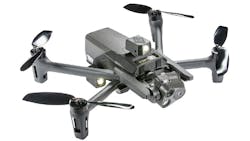New drone lighting system enhances nighttime search and rescue capabilities
In this week’s roundup from the Association for Unmanned Vehicle Systems International, which highlights some of the latest news and headlines in unmanned vehicles and robotics, enhancements for drones designed for first responders, drones for river search and rescue missions, and new drone swarm tests.
Parrot, FoxFury Lighting Solutions design tailored lighting system for Parrot's ANAFI drone
Parrot has partnered with professional drone lighting company FoxFury Lighting Solutions to enhance its ANAFI USA drone, which is designed for first responders and enterprise professionals.
The companies collaborated to develop a tailored system for ANAFI that allows professionals to attach up to three D10 lights modules on the drone.
Made in the U.S., the intuitive saddle mounting system and the lights provide up to 40 minutes of continuous use in “High” mode and 80 minutes in “Strobe” mode, with self-contained LiPo batteries. This solution will allow professionals from the public safety and inspection verticals to extend crucial work in the most extreme situations, such as a search and rescue mission at night or traveling through dimly lit structures like tunnels.
“With more industries using drones, we saw an opportunity with Parrot to provide a one-of-a-kind option for professionals looking to brighten their surroundings,” says Mario Cugini, CEO of FoxFury Lighting Solutions.
“Our new lights on an ANAFI drone will provide a unique and crucial resource for professionals like first responders in high-risk environments.”
Iris Automation demonstrates Casia DAA system for Reno Fire Department
Last week, Iris Automation conducted a live drone flight demonstration of its Casia onboard Detect-and-Avoid (DAA) collision avoidance system for the City of Reno Fire Department. The demonstration was performed under the FAA’s UAS Integration Pilot Program (IPP).
During the demonstration, which took place in Nevada over the Carson River at Fort Churchill State Historic Park, a drone equipped with Casia showcased how this technology will be used to provide automated situational awareness for drones and their pilots. Casia enables safe beyond visual line of sight (BVLOS) drone operations.
“Through this CONOP, we aim to implement rescue operations supported by drone technology within the Truckee River region in the near future,” says Reno Fire Chief Dave Cochran.
“Water exposure, especially in moving-water incidents, is extremely dynamic and dangerous for victims and first responders. The use of drones will increase our safety and increase our efficiency. I’m thrilled that we’re looking for an innovative approach to help improve our river response.”
According to Iris Automation, the River Search and Rescue program will test the safety and capability of using drones during river rescue missions to improve response times and reduce exposure of both first responders and victims to dangerous conditions during river rescue operations.
Iris Automation says the program has the potential to increase the survival rate of victims during river rescue operations while helping to develop safe practices for drone usage throughout the United States.
“The City of Reno has been a leader in the UAS community, and this demonstration is another example of the application of these technologies for public benefit,” says Jon Damush, CEO of Iris Automation.
“Our priority at Iris is the safe integration of UAS into the airspace, and we are excited to continue our partnership with the City of Reno and the FAA to extend these capabilities to the Fire Department and First Responders.
Blue Bear Systems' 20-drone swarm conducts BVLOS operations
Blue Bear Systems recently operated 20 fixed wing drones to form a collaborative heterogeneous swarm that conducted beyond visual line of sight (BVLOS) operations.
The heterogeneous swarm built off of a 12-drone swarm that Blue Bear demonstrated in July. The latest heterogeneous swarm was made up of five different types and sizes of fixed wing Blue Bear drones, including Vertical Take Off and Landing (VTOL) fixed wing Ghost/Modular Ghost UAS, conventional fixed wing Red Kite UAS, conventional fixed wing Cobra UAS and smaller hand launched Flat Pack UAS.
“Demonstrating BVLOS operations of a 20-drone swarm shows how far we have come in the 18 months this project has been running,” says Ian Williams-Wynn, MD.
“I am so proud of the whole team who have put a phenomenal amount of effort in to deliver the UK’s most complex autonomous air vehicle trial ever!”
Six different types of payload from five different companies were integrated into the swarm through Blue Bear plug and play open architectures and SmartConnectTM technology. Plextek DTS, IQHQ, Airbus, RFEL, Durham University, and Blue Bear all provided payloads and payload support.
The drones flew simultaneous Beyond Visual Line of Sight (BVLOS) cooperative tasks, with Blue Bear collaborative autonomy ensuring they all contributed to overall mission goals.
Three operators in Blue Bear’s Mobile Mission Command System (MCCS) commanded the swarm of 20, whilst simultaneously handling different, collaborative payload analysis tasks.
Blue Bear’s Artificial Intelligence platform (BBAI) was running on a number of the UAS Swarm, and processing sensor data on the aircraft before sending only relevant data back to the ground, which helped further reduce the burden on the operator.
To help automatic deconfliction of BVLOS flights within the swarm, and to track the presence of any third party aircraft, Blue Bear Airspace Deconfliction Layer (ADL) technology was running in the background.
Throughout the two weeks of trials, Blue Bear regularly operated swarms of 10 to 14 collaborative UAS. The company flew more than 220 UAS sorties, building up to be able to operate a 20 UAS swarm. The trials concluded with a multi-vehicle ‘button click’ to launch simultaneous take off and mission deployment of four Ghost UAS in 30knt winds.
Compiled by Brian Sprowl, Associate Editor, AUVSI
Share your vision-related news by contacting Dennis Scimeca, Associate Editor, Vision Systems Design
SUBSCRIBE TO OUR NEWSLETTERS


